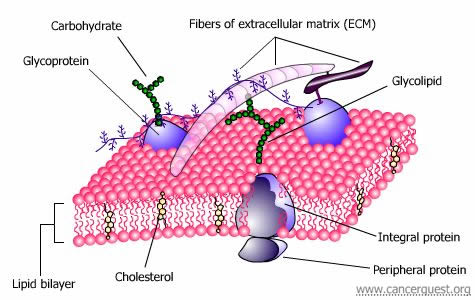Lipids
Lipids are water-insoluble (nonpolar) molecules that are soluble in weakly polar or nonpolar solvents such as chloroform. The most important function that lipids perform for all kinds of cells stems from their ability to form sheetlike membranes. The plasma membrane of both prokaryotic and eukaryotic cells separates the cellular contents from the external environment, thus allowing the cell to function as a unit of life. Eukaryotic cells also have internal membranes, such as those of the ER, nucleus, mitochondrion, and chloroplast, that further compartmentalize the cell for specific functions. The other important function of lipids is as efficient energy storage molecules.
There are three major kinds of membrane lipids: phospholipids, glycolipids, and sterols. Both phospholipids and glycolipids readily associate spontaneously to form a lipid bilayer (Figure 2-2). Cellular membranes behave as two-dimensional, semifluid structures, allowing embedded protein molecules to constantly move about rather freely by lateral diffusion. The fluidity of prokaryotic membranes is regulated by varying the number of double bonds in, and the lengths of, the fatty acid chains of the lipid molecules constituting the membrane. In animals, the quantity of the sterol lipid cholesterol is a key regulator of membrane fluidity.
 |
| Figure 2-2 Lipid bilayer membrane. |
The plasma membrane is a selective filter that controls the entry of nutrients and other molecules needed for cellular processes. Waste products of metabolism pass out of the cell through this membrane. Due to their composition, membranes have a low permeability for ions and most polar molecules, thus these molecules must pass through channels formed from integral membrane proteins. If a substance is moving against its concentration gradient (i.e., from an area of lower concentration to an area of higher concentration), then energy must be expended. This is termed active transport.




